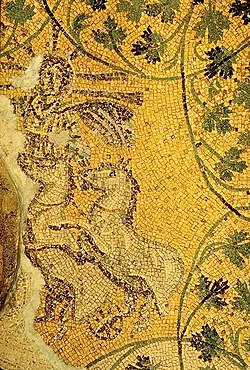| Revision as of 10:07, 18 December 2024 editSpeederzzz (talk | contribs)Extended confirmed users1,566 editsm another quick note so I won't forget what I wanted to edit← Previous edit | Revision as of 11:23, 18 December 2024 edit undo174.198.3.40 (talk)No edit summaryTags: Mobile edit Mobile web editNext edit → | ||
| Line 13: | Line 13: | ||
| }} | }} | ||
| The popularly named "'''Tomb of the Julii'''" (Mausoleum "M") survives in the ] beneath ]. The serendipitous discovery near the ] has a vaulted ceiling bearing a ] depicting ] with an ] riding in his chariot, within a framing of rinceaux of vine leaves. <!-- ref Beckwith --> While scholars agree that this is a depiction of Apollo |
The popularly named "'''Tomb of the Julii'''" (Mausoleum "M") survives in the ] beneath ]. The serendipitous discovery near the ] has a vaulted ceiling bearing a ] depicting ] with an ] riding in his chariot, within a framing of rinceaux of vine leaves. <!-- ref Beckwith --> While scholars agree that this is a depiction of Apollo as Jesus, this mosaic is from the Tardo period (]) in which ] and Apollo were often merged.{{citation needed|date= December 2024}} Other mosaics in this tomb depicting Jonah and the whale, the good shepherd carrying a lamb (the '']'' motif), and fishermen have encouraged its interpretation as a Christian tomb. <!-- ref Beckwith --> | ||
| This tomb was first discovered in 1574 AD when workmen accidentally broke through the ceiling while conducting some floor alterations in the basilica. The inside was briefly explored and documented before the opening was sealed over once more.<ref>{{cite book |last = Evangelist Walsh |first = John | author-link = John Evangelist Walsh |date = 1985 |title = The Bones of St. Peter: The First Full Account of the Search for the Apostles Body |url = https://archive.org/details/bonesofstpeter00wals/page/n7/mode/2up |location = Garden City, New York | publisher = Image Books |page = 15 | isbn = 978-1933184753}} <!-- should internet archive go down, internet copy can be found here: https://stpetersbasilica.info/Necropolis/JW/TheBonesofStPeter-1.htm --></ref> | This tomb was first discovered in 1574 AD when workmen accidentally broke through the ceiling while conducting some floor alterations in the basilica. The inside was briefly explored and documented before the opening was sealed over once more.<ref>{{cite book |last = Evangelist Walsh |first = John | author-link = John Evangelist Walsh |date = 1985 |title = The Bones of St. Peter: The First Full Account of the Search for the Apostles Body |url = https://archive.org/details/bonesofstpeter00wals/page/n7/mode/2up |location = Garden City, New York | publisher = Image Books |page = 15 | isbn = 978-1933184753}} <!-- should internet archive go down, internet copy can be found here: https://stpetersbasilica.info/Necropolis/JW/TheBonesofStPeter-1.htm --></ref> | ||
Revision as of 11:23, 18 December 2024
Part of the Vatican Necropolis| Tomb of the Julii | |
|---|---|
 Detail of the mosaic Detail of the mosaic | |
| Click on the map for a fullscreen view | |
| General information | |
| Location | Vatican City |
| Coordinates | 41°54′8″N 12°27′12″E / 41.90222°N 12.45333°E / 41.90222; 12.45333 |
The popularly named "Tomb of the Julii" (Mausoleum "M") survives in the Vatican Necropolis beneath St. Peter's Basilica. The serendipitous discovery near the crypt has a vaulted ceiling bearing a mosaic depicting Apollo with an aureole riding in his chariot, within a framing of rinceaux of vine leaves. While scholars agree that this is a depiction of Apollo as Jesus, this mosaic is from the Tardo period (Low Roman Empire) in which Helios and Apollo were often merged. Other mosaics in this tomb depicting Jonah and the whale, the good shepherd carrying a lamb (the kriophoros motif), and fishermen have encouraged its interpretation as a Christian tomb.
This tomb was first discovered in 1574 AD when workmen accidentally broke through the ceiling while conducting some floor alterations in the basilica. The inside was briefly explored and documented before the opening was sealed over once more.
See also
References
- Beckwith, John 1979. Early Christian and Byzantine Art (Yale University Press): 19
- Perler, Othmar 1953, Die Mosaiken der Juliergruft im Vatikan (Universitätsverlag): 34–36
- Walsh, John Evangelist. The Bones of Saint Peter (The Chaucer Press): 15
- Specific
- Evangelist Walsh, John (1985). The Bones of St. Peter: The First Full Account of the Search for the Apostles Body. Garden City, New York: Image Books. p. 15. ISBN 978-1933184753.
Further reading
- Weitzmann, Kurt, ed., Age of spirituality: late antique and early Christian art, third to seventh century, no. 467, 1979, Metropolitan Museum of Art, New York, ISBN 9780870991790